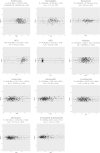Hilab system, a new point-of-care hematology analyzer supported by the Internet of Things and Artificial Intelligence
- PMID: 35729182
- PMCID: PMC9213419
- DOI: 10.1038/s41598-022-13913-8
Hilab system, a new point-of-care hematology analyzer supported by the Internet of Things and Artificial Intelligence
Abstract
The complete blood count (CBC) is one of the most requested tests by physicians. CBC tests, most realized in conventional hematological analyzers, are restricted to centralized laboratories due to frequent maintenance, large devices, and expensive costs required. On the other hand, most handheld CBC devices commercially available show high prices and are not liable to calibration or control procedures, which results in poor quality compared to standard hematology instruments. The Hilab system is a small-handed hematological platform that uses microscopy and chromatography techniques for blood cells and hematimetric parameters analysis through artificial intelligence, machine learning, and deep learning techniques. For clinical evaluation of the handheld CBC device, 450 blood samples were analyzed. The samples encompassed normal (82%) and pathological conditions (18%), such as thalassemias (2.2%), anemias (6.6%), and infections (9.2%). For all analytes, accuracy, precision, method comparison, and flagging capabilities of the Hilab System, were compared with the Sysmex XE-2100 (Sysmex, Japan) results. The sample source (venous and capillary) influences were also evaluated. Pearson correlation, Student t test, bias, and the Bland-Altman plot of each blood count analyte were calculated and shown. The significance level was set at p ≤ 0.05. For clinical evaluation, Hilab System and the Sysmex XE-2100 showed a strong correlation (r ≥ 0.9) for most evaluated parameters. In the precision study, analytes showed CV inside the limits established according to European Federation of Clinical Chemistry and Laboratory Medicine guidelines. The flagging capabilities of the Hilab system, compared to the manual microscopy technique, presented high sensibility, specificity, and accuracy. Venous and capillary samples (p > 0.05) do not differ statistically. Considering the need for point-of-care CBCs, the study indicated that the Hilab system provides fast, accurate, low cost, and robust analysis for reliable clinical use.
© 2022. The Author(s).
Conflict of interest statement
M. V. M. Figueredo is the CEO at Hilab; S. R. Rogal Júnior is the CTO at Hilab; A. T. Gasparin is microscopy manager at Hilab; C. I. F. Araujo, P. Schmitt, M. R. Cardoso, M. C. Perussolo, and T. C. S. Jesus are health researchers at Hilab; E. B. Santiago is R&D manager at Hilab; I. L. R. Silva is head of R&D at Hilab; R. G. Souza and F. Z. Teng are R&D researchers at Hilab; E. B. Severo is computer vision engineer at Hilab; V. H. A. Ribeiro is head of A.I at Hilab; M. A. Cardoso and F. D. Silva are A.I researchers at Hilab; C. R. A. Perazzoli is marketing analyst at Hilab; J. S. H. Farias is assistant doctor at Erasto Gaertner Hospital; B. M. M. Almeida is medical director at Hilab.
Figures




References
-
- World Health Organization . The Selection and Use of Essential In Vitro Diagnostics. World Health Organization; 2020.
Publication types
MeSH terms
LinkOut - more resources
Full Text Sources

